Unit – 6
Probability
Q1) What do you understand by random variable?
A1)
A random variable is a real-valued function whose domain is a set of possible outcomes of a random experiment and range is a sub-set of the set of real numbers and has the following properties:
i) Each particular value of the random variable can be assigned some probability
Ii) Uniting all the probabilities associated with all the different values of the random variable gives the value 1.
A random variable is denoted by X, Y, Z etc.
For example if a random experiment E consists of tossing a pair of dice, the sum X of the two numbers which turn up have the value 2,3,4,…12 depending on chance. Then X is a random variable
Q2) What is discrete random variable?
Q3)
A random variable is said to be discrete if it has either a finite or a countable number of values. Countable number of values means the values which can be arranged in a sequence.
Note- if a random variable takes a finite set of values it is called discrete and if if a random variable takes an infinite number of uncountable values it is called continuous variable.
Q4) Find the probability distribution of the number of heads when three coins are tossed simultaneously.
A3)
Let be the number of heads in the toss of three coints
The sample space will be-
{HHH, HHT, HTH, THH, HTT, THT, TTH, TTT}
Here variable X can take the values 0, 1, 2, 3 with the following probabilities-
P[X= 0] = P[TTT] = 1/8
P[X = 1] = P [HTT, THH, TTH] = 3/8
P[X = 2] = P[HHT, HTH, THH] = 3/8
P[X = 3] = P[HHH] = 1/8
Hence the probability distribution of X will be-
X |  |  |  |  |
P(x) |  |  |  |  |
Q5) What is independent random variable?
A4) Two discrete random variables X and Y are said to be independent only if-

Note- Two events are independent only if 
Q6) Two discrete random variables X and Y have-
P[X = 0, Y = 0] = 2/9, P[X = 0, Y = 1] = 1/9, P[X = 1, Y = 0] = 1/9
And
P[X = 1, Y = 1] = 5/9.
Check whether X and Y are independent or not?
A5)
First we write the given distribution In tabular form-
X/Y | 0 | 1 | P(x) |
0 | 2/9 | 1/9 | 3/9 |
1 | 1/9 | 5/9 | 6/9 |
P(y) | 3/9 | 6/9 | 1 |


Now-

But

So that-

Hence X and Y are not independent.
Q7) Define continuous random variable.
A6)
A continuous random variable is a random variable where the data can take infinitely many values. For example, a random variable measuring the time taken for something to be done is continuous since there are an infinite number of possible times that can be taken.
Continuous random variable is called by a probability density function p (x), with given properties: p (x) ≥ 0 and the area between the x-axis & the curve is 1: ... Standard deviation of a variable Random is defined by σ x = √Variance (x).
Q8) What do you understand by probability density function?
A7)
When a random variable X takes every value in an interval, it gives to continuous distribution of X.
The probability distribution of a continuous variate x defined by a function f(x) such that the probabilities of the variate x falling in the interval 
We express it as-

Here f(x) is called the probability density function.
Q9) If a continuous random variable X has the following probability density function)

Then find- P[0.2 < X < 0.5]
A8)
Here f(x) is the probability density function, then-



Q10) The probability density function of a variable X is
X | 0 | 1 | 2 | 3 | 4 | 5 | 6 |
P(X) | k | 3k | 5k | 7k | 9k | 11k | 13k |
(i) Find 
(ii) What will be e minimum value of k so that 
A9)
(i) If X is a random variable then





(ii)Thus minimum value of k=1/30.
Q11) A random variate X has the following probability function
x | 0 | 1 | 2 | 3 | 4 | 5 | 6 | 7 |
P (x) | 0 | k | 2k | 2k | 3k |  |  |  |
(i) Find the value of the k.
(ii) 
A10)
(i) If X is a random variable then







Q12) Show that the following function can be defined as a density function and then find  .
.


A11)
Here

So that, the function can be defined as a density function.
Now.

Q13) Let X be a continuous random variable with PDF

Find  .
.
A12)
We have



Q14) If on an average one ship in every ten is wrecked. Find the probability that out of 5 ships expected to arrive, 4 at least we will arrive safely.
A13)
Out of 10 ships one ship is wrecked.
I.e. nine ships out of 10 ships are safe, P (safety) = 
P (at least 4 ships out of 5 are safe) = P (4 or 5) = P (4) + P(5)

Q15) The overall percentage of failures in a certain examination is 20. If 6 candidates appear in the examination what is the probability that at least five pass the examination?
A14)
Probability of failures = 20% 
Probability of (P) = 
Probability of at least 5 pass = P(5 or 6)


Q16) Assuming that 20% of the population of a city are literate so that the chance of an individual being literate is  and assuming that hundred investigators each take 10 individuals to see whether they are illiterate, how many investigators would you expect to report 3 or less were literate.
and assuming that hundred investigators each take 10 individuals to see whether they are illiterate, how many investigators would you expect to report 3 or less were literate.
A15)




Required number of investigators = 0.879126118× 100 =87.9126118
= 88 approximate
Q17) A die is tossed thrice. A success is getting 1 or 6 on a TOSS. Find the mean and variance of the number of successes.
A16)



Q18) Assume that the probability of an individual coal miner being killed in a mine accident during a year is  . Use appropriate statistical distribution to calculate the probability that in a mine employing 200 miners, there will be at least one fatal accident in a year.
. Use appropriate statistical distribution to calculate the probability that in a mine employing 200 miners, there will be at least one fatal accident in a year.
A17)






Q19) Suppose 3% of bolts made by a machine are defective, the defects occuring at random during production. If bolts are packaged 50 per box, find
(a) Exact probability and
(b) Poisson approximation to it, that a given box will contain 5 defectives.
A18)


(a) Hence the probability for 5 defectives bolts in a lot of 50.

(b) To get Poisson approximation m = np =
Required Poisson approximation=
Q20) If a random variable X is normally distributed with mean 80 and standard deviation 5, then find-
1. P[X > 95]
2. P[X < 72]
3. P [85 < X <97]
[Note- use the table- area under the normal curve]
A19)
The standard normal variate is – 
Now-
1. X = 95,

So that-




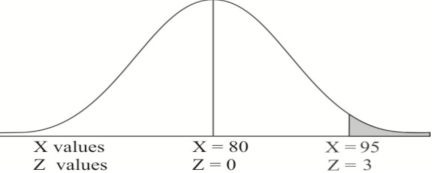
2. X = 72,

So that-





3. X = 85,

X = 97,

So that-




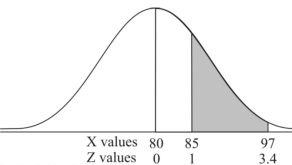
Q21) The mean inside diameter of a sample of 200 washers produced by a machine is 0.0502 cm and the standard deviation is 0.005 cm. The purpose for which these washers are intended allows a maximum tolerance in the diameter of 0.496 to 0.508 cm, otherwise the washers are considered defective. Determine the percentage of defective washers produced by the machine, assuming the diameters are normally distributed.
A20)
Here-

And

Area for non-defective washers = area between z = -1.2 to +1.2
= 2 area between z = 0 and z = 1.2
= 2 × 0.3849 = 0.7698 = 76.98%
Then percent of defective washers = 100 – 76.98 = 23.02 %
Unit – 6
Probability
Q1) What do you understand by random variable?
A1)
A random variable is a real-valued function whose domain is a set of possible outcomes of a random experiment and range is a sub-set of the set of real numbers and has the following properties:
i) Each particular value of the random variable can be assigned some probability
Ii) Uniting all the probabilities associated with all the different values of the random variable gives the value 1.
A random variable is denoted by X, Y, Z etc.
For example if a random experiment E consists of tossing a pair of dice, the sum X of the two numbers which turn up have the value 2,3,4,…12 depending on chance. Then X is a random variable
Q2) What is discrete random variable?
Q3)
A random variable is said to be discrete if it has either a finite or a countable number of values. Countable number of values means the values which can be arranged in a sequence.
Note- if a random variable takes a finite set of values it is called discrete and if if a random variable takes an infinite number of uncountable values it is called continuous variable.
Q4) Find the probability distribution of the number of heads when three coins are tossed simultaneously.
A3)
Let be the number of heads in the toss of three coints
The sample space will be-
{HHH, HHT, HTH, THH, HTT, THT, TTH, TTT}
Here variable X can take the values 0, 1, 2, 3 with the following probabilities-
P[X= 0] = P[TTT] = 1/8
P[X = 1] = P [HTT, THH, TTH] = 3/8
P[X = 2] = P[HHT, HTH, THH] = 3/8
P[X = 3] = P[HHH] = 1/8
Hence the probability distribution of X will be-
X |  |  |  |  |
P(x) |  |  |  |  |
Q5) What is independent random variable?
A4) Two discrete random variables X and Y are said to be independent only if-

Note- Two events are independent only if 
Q6) Two discrete random variables X and Y have-
P[X = 0, Y = 0] = 2/9, P[X = 0, Y = 1] = 1/9, P[X = 1, Y = 0] = 1/9
And
P[X = 1, Y = 1] = 5/9.
Check whether X and Y are independent or not?
A5)
First we write the given distribution In tabular form-
X/Y | 0 | 1 | P(x) |
0 | 2/9 | 1/9 | 3/9 |
1 | 1/9 | 5/9 | 6/9 |
P(y) | 3/9 | 6/9 | 1 |


Now-

But

So that-

Hence X and Y are not independent.
Q7) Define continuous random variable.
A6)
A continuous random variable is a random variable where the data can take infinitely many values. For example, a random variable measuring the time taken for something to be done is continuous since there are an infinite number of possible times that can be taken.
Continuous random variable is called by a probability density function p (x), with given properties: p (x) ≥ 0 and the area between the x-axis & the curve is 1: ... Standard deviation of a variable Random is defined by σ x = √Variance (x).
Q8) What do you understand by probability density function?
A7)
When a random variable X takes every value in an interval, it gives to continuous distribution of X.
The probability distribution of a continuous variate x defined by a function f(x) such that the probabilities of the variate x falling in the interval 
We express it as-

Here f(x) is called the probability density function.
Q9) If a continuous random variable X has the following probability density function)

Then find- P[0.2 < X < 0.5]
A8)
Here f(x) is the probability density function, then-



Q10) The probability density function of a variable X is
X | 0 | 1 | 2 | 3 | 4 | 5 | 6 |
P(X) | k | 3k | 5k | 7k | 9k | 11k | 13k |
(i) Find 
(ii) What will be e minimum value of k so that 
A9)
(i) If X is a random variable then





(ii)Thus minimum value of k=1/30.
Q11) A random variate X has the following probability function
x | 0 | 1 | 2 | 3 | 4 | 5 | 6 | 7 |
P (x) | 0 | k | 2k | 2k | 3k |  |  |  |
(i) Find the value of the k.
(ii) 
A10)
(i) If X is a random variable then







Q12) Show that the following function can be defined as a density function and then find  .
.


A11)
Here

So that, the function can be defined as a density function.
Now.

Q13) Let X be a continuous random variable with PDF

Find  .
.
A12)
We have



Q14) If on an average one ship in every ten is wrecked. Find the probability that out of 5 ships expected to arrive, 4 at least we will arrive safely.
A13)
Out of 10 ships one ship is wrecked.
I.e. nine ships out of 10 ships are safe, P (safety) = 
P (at least 4 ships out of 5 are safe) = P (4 or 5) = P (4) + P(5)

Q15) The overall percentage of failures in a certain examination is 20. If 6 candidates appear in the examination what is the probability that at least five pass the examination?
A14)
Probability of failures = 20% 
Probability of (P) = 
Probability of at least 5 pass = P(5 or 6)


Q16) Assuming that 20% of the population of a city are literate so that the chance of an individual being literate is  and assuming that hundred investigators each take 10 individuals to see whether they are illiterate, how many investigators would you expect to report 3 or less were literate.
and assuming that hundred investigators each take 10 individuals to see whether they are illiterate, how many investigators would you expect to report 3 or less were literate.
A15)




Required number of investigators = 0.879126118× 100 =87.9126118
= 88 approximate
Q17) A die is tossed thrice. A success is getting 1 or 6 on a TOSS. Find the mean and variance of the number of successes.
A16)



Q18) Assume that the probability of an individual coal miner being killed in a mine accident during a year is  . Use appropriate statistical distribution to calculate the probability that in a mine employing 200 miners, there will be at least one fatal accident in a year.
. Use appropriate statistical distribution to calculate the probability that in a mine employing 200 miners, there will be at least one fatal accident in a year.
A17)






Q19) Suppose 3% of bolts made by a machine are defective, the defects occuring at random during production. If bolts are packaged 50 per box, find
(a) Exact probability and
(b) Poisson approximation to it, that a given box will contain 5 defectives.
A18)


(a) Hence the probability for 5 defectives bolts in a lot of 50.

(b) To get Poisson approximation m = np =
Required Poisson approximation=
Q20) If a random variable X is normally distributed with mean 80 and standard deviation 5, then find-
1. P[X > 95]
2. P[X < 72]
3. P [85 < X <97]
[Note- use the table- area under the normal curve]
A19)
The standard normal variate is – 
Now-
1. X = 95,

So that-




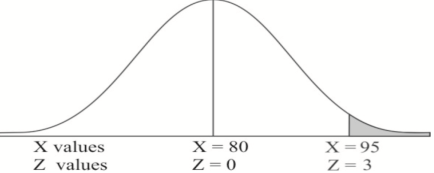
2. X = 72,

So that-




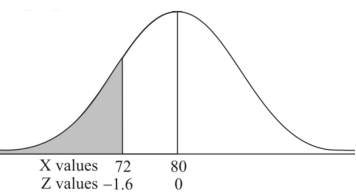
3. X = 85,

X = 97,

So that-





Q21) The mean inside diameter of a sample of 200 washers produced by a machine is 0.0502 cm and the standard deviation is 0.005 cm. The purpose for which these washers are intended allows a maximum tolerance in the diameter of 0.496 to 0.508 cm, otherwise the washers are considered defective. Determine the percentage of defective washers produced by the machine, assuming the diameters are normally distributed.
A20)
Here-

And

Area for non-defective washers = area between z = -1.2 to +1.2
= 2 area between z = 0 and z = 1.2
= 2 × 0.3849 = 0.7698 = 76.98%
Then percent of defective washers = 100 – 76.98 = 23.02 %
Unit – 6
Unit – 6
Unit – 6
Probability
Q1) What do you understand by random variable?
A1)
A random variable is a real-valued function whose domain is a set of possible outcomes of a random experiment and range is a sub-set of the set of real numbers and has the following properties:
i) Each particular value of the random variable can be assigned some probability
Ii) Uniting all the probabilities associated with all the different values of the random variable gives the value 1.
A random variable is denoted by X, Y, Z etc.
For example if a random experiment E consists of tossing a pair of dice, the sum X of the two numbers which turn up have the value 2,3,4,…12 depending on chance. Then X is a random variable
Q2) What is discrete random variable?
Q3)
A random variable is said to be discrete if it has either a finite or a countable number of values. Countable number of values means the values which can be arranged in a sequence.
Note- if a random variable takes a finite set of values it is called discrete and if if a random variable takes an infinite number of uncountable values it is called continuous variable.
Q4) Find the probability distribution of the number of heads when three coins are tossed simultaneously.
A3)
Let be the number of heads in the toss of three coints
The sample space will be-
{HHH, HHT, HTH, THH, HTT, THT, TTH, TTT}
Here variable X can take the values 0, 1, 2, 3 with the following probabilities-
P[X= 0] = P[TTT] = 1/8
P[X = 1] = P [HTT, THH, TTH] = 3/8
P[X = 2] = P[HHT, HTH, THH] = 3/8
P[X = 3] = P[HHH] = 1/8
Hence the probability distribution of X will be-
X |  |  |  |  |
P(x) |  |  |  |  |
Q5) What is independent random variable?
A4) Two discrete random variables X and Y are said to be independent only if-

Note- Two events are independent only if 
Q6) Two discrete random variables X and Y have-
P[X = 0, Y = 0] = 2/9, P[X = 0, Y = 1] = 1/9, P[X = 1, Y = 0] = 1/9
And
P[X = 1, Y = 1] = 5/9.
Check whether X and Y are independent or not?
A5)
First we write the given distribution In tabular form-
X/Y | 0 | 1 | P(x) |
0 | 2/9 | 1/9 | 3/9 |
1 | 1/9 | 5/9 | 6/9 |
P(y) | 3/9 | 6/9 | 1 |


Now-

But

So that-

Hence X and Y are not independent.
Q7) Define continuous random variable.
A6)
A continuous random variable is a random variable where the data can take infinitely many values. For example, a random variable measuring the time taken for something to be done is continuous since there are an infinite number of possible times that can be taken.
Continuous random variable is called by a probability density function p (x), with given properties: p (x) ≥ 0 and the area between the x-axis & the curve is 1: ... Standard deviation of a variable Random is defined by σ x = √Variance (x).
Q8) What do you understand by probability density function?
A7)
When a random variable X takes every value in an interval, it gives to continuous distribution of X.
The probability distribution of a continuous variate x defined by a function f(x) such that the probabilities of the variate x falling in the interval 
We express it as-

Here f(x) is called the probability density function.
Q9) If a continuous random variable X has the following probability density function)

Then find- P[0.2 < X < 0.5]
A8)
Here f(x) is the probability density function, then-



Q10) The probability density function of a variable X is
X | 0 | 1 | 2 | 3 | 4 | 5 | 6 |
P(X) | k | 3k | 5k | 7k | 9k | 11k | 13k |
(i) Find 
(ii) What will be e minimum value of k so that 
A9)
(i) If X is a random variable then





(ii)Thus minimum value of k=1/30.
Q11) A random variate X has the following probability function
x | 0 | 1 | 2 | 3 | 4 | 5 | 6 | 7 |
P (x) | 0 | k | 2k | 2k | 3k |  |  |  |
(i) Find the value of the k.
(ii) 
A10)
(i) If X is a random variable then







Q12) Show that the following function can be defined as a density function and then find  .
.


A11)
Here

So that, the function can be defined as a density function.
Now.

Q13) Let X be a continuous random variable with PDF

Find  .
.
A12)
We have



Q14) If on an average one ship in every ten is wrecked. Find the probability that out of 5 ships expected to arrive, 4 at least we will arrive safely.
A13)
Out of 10 ships one ship is wrecked.
I.e. nine ships out of 10 ships are safe, P (safety) = 
P (at least 4 ships out of 5 are safe) = P (4 or 5) = P (4) + P(5)

Q15) The overall percentage of failures in a certain examination is 20. If 6 candidates appear in the examination what is the probability that at least five pass the examination?
A14)
Probability of failures = 20% 
Probability of (P) = 
Probability of at least 5 pass = P(5 or 6)


Q16) Assuming that 20% of the population of a city are literate so that the chance of an individual being literate is  and assuming that hundred investigators each take 10 individuals to see whether they are illiterate, how many investigators would you expect to report 3 or less were literate.
and assuming that hundred investigators each take 10 individuals to see whether they are illiterate, how many investigators would you expect to report 3 or less were literate.
A15)




Required number of investigators = 0.879126118× 100 =87.9126118
= 88 approximate
Q17) A die is tossed thrice. A success is getting 1 or 6 on a TOSS. Find the mean and variance of the number of successes.
A16)



Q18) Assume that the probability of an individual coal miner being killed in a mine accident during a year is  . Use appropriate statistical distribution to calculate the probability that in a mine employing 200 miners, there will be at least one fatal accident in a year.
. Use appropriate statistical distribution to calculate the probability that in a mine employing 200 miners, there will be at least one fatal accident in a year.
A17)






Q19) Suppose 3% of bolts made by a machine are defective, the defects occuring at random during production. If bolts are packaged 50 per box, find
(a) Exact probability and
(b) Poisson approximation to it, that a given box will contain 5 defectives.
A18)


(a) Hence the probability for 5 defectives bolts in a lot of 50.

(b) To get Poisson approximation m = np =
Required Poisson approximation=
Q20) If a random variable X is normally distributed with mean 80 and standard deviation 5, then find-
1. P[X > 95]
2. P[X < 72]
3. P [85 < X <97]
[Note- use the table- area under the normal curve]
A19)
The standard normal variate is – 
Now-
1. X = 95,

So that-




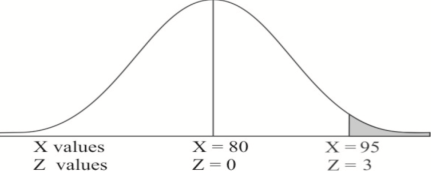
2. X = 72,

So that-




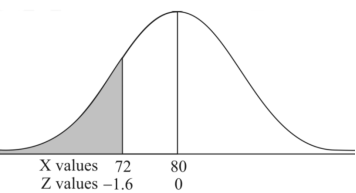
3. X = 85,

X = 97,

So that-




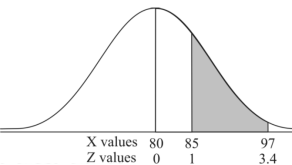
Q21) The mean inside diameter of a sample of 200 washers produced by a machine is 0.0502 cm and the standard deviation is 0.005 cm. The purpose for which these washers are intended allows a maximum tolerance in the diameter of 0.496 to 0.508 cm, otherwise the washers are considered defective. Determine the percentage of defective washers produced by the machine, assuming the diameters are normally distributed.
A20)
Here-

And

Area for non-defective washers = area between z = -1.2 to +1.2
= 2 area between z = 0 and z = 1.2
= 2 × 0.3849 = 0.7698 = 76.98%
Then percent of defective washers = 100 – 76.98 = 23.02 %